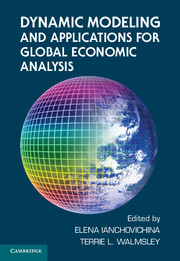Book contents
- Frontmatter
- Contents
- Contributors
- Acknowledgments
- PART I INTRODUCTION AND OVERVIEW
- 1 Introduction
- PART II STRUCTURE OF THE DYNAMIC GTAP FRAMEWORK
- PART III APPLICATIONS OF DYNAMIC GTAP
- PART IV EVALUATION OF THE DYNAMIC GTAP FRAMEWORK
- Appendix: Negative Investment: Incorporating a Complementarity into the Dynamic GTAP Model
- Glossary of GDyn Notation
- Index
- References
1 - Introduction
Published online by Cambridge University Press: 05 June 2012
- Frontmatter
- Contents
- Contributors
- Acknowledgments
- PART I INTRODUCTION AND OVERVIEW
- 1 Introduction
- PART II STRUCTURE OF THE DYNAMIC GTAP FRAMEWORK
- PART III APPLICATIONS OF DYNAMIC GTAP
- PART IV EVALUATION OF THE DYNAMIC GTAP FRAMEWORK
- Appendix: Negative Investment: Incorporating a Complementarity into the Dynamic GTAP Model
- Glossary of GDyn Notation
- Index
- References
Summary
The objective of the Global Trade Analysis Project (GTAP), launched in 1992, was to lower the cost of entry into the world of applied computable general equilibrium (CGE or AGE) modeling using a global, economy-wide framework. The birth of the GTAP project and the subsequent publication of the GTAP book (Hertel 1997), which documented the model structure, data, and software, were timely because there was an increasing demand for quantitative analyses of trade policy issues on a global basis. Most notably, the Uruguay Round negotiations under the auspices of the General Agreement on Tariffs and Trade (GATT) were a catalyst in moving forward the GTAP database and model, as were the heated debates over the North American Free Trade Agreement (NAFTA) and subsequently the World Trade Organization's (WTO) Doha Development Agenda. In response to this demand, the GTAP project grew from a few people in a handful of countries in 1992 to more than 8,500 people from 140 countries in 2010; the GTAP book has been widely cited; and the GTAP model and data have been actively used by a large number of public institutions around the world and in analyses on various topics published in numerous refereed journals, books, and reports.
- Type
- Chapter
- Information
- Publisher: Cambridge University PressPrint publication year: 2012



